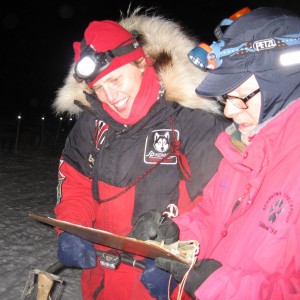Aliy Zirkle and Allen Moore were featured at a meet and greet sponsored by Clarion Suites of Anchorage. The first couple of the Yukon Quest shared stories about past race adventures and gave detailed information about their equipment. One thing neither of the SP Kennel owners talked about was their Iditarod strategy.
Just a month before the start of Iditarod, Zirkle and Moore were departing Fairbanks by dog team, participating in Yukon Quest races. Zirkle, the Y2K Quest Champion was running the Yukon Quest 300 and Allen, running the 1,000 mile race was on track to defend his 2013 Quest Championship.
Trail permitting, Moore and Zirkle both employ a double poling technique. Mushers don’t just stand on the runners and let the dogs do the work. They are actively involved in assisting the dogs in moving the sled. Commonly seen is a technique known as pedaling where a musher stands on a runner with one foot and smoothly plants and pushes with the other. Some use one ski pole to smoothly add force. Agile mushers sometimes combine the two movements. Allen and Aliy stand on the runners with a ski pole in each hand and pole in a similar fashion to a classic skier. With their force added to the power of the dog team, seems like they are the 17th dog.
 On more than one occasion, Zirkle and Moore have been heard saying, it’s the musher that’s the weakest link of the team and a team is only as powerful as its weakest link. When Moore lost the Quest to Hugh Neff by 26 seconds in 2011, he said his team was strong but he was the weakest link. Twice in Nome when Aliy finished second to the Seaveys, she commented that the dogs were the athletes but she herself was the weakest link. Zirkle and Moore didn’t just talk the talk. They’ve both participated in strength and conditioning programs to bring themselves up to the level of their athletes. Seems it paid great dividends for the SP Kennel Partners in the Quest.
On more than one occasion, Zirkle and Moore have been heard saying, it’s the musher that’s the weakest link of the team and a team is only as powerful as its weakest link. When Moore lost the Quest to Hugh Neff by 26 seconds in 2011, he said his team was strong but he was the weakest link. Twice in Nome when Aliy finished second to the Seaveys, she commented that the dogs were the athletes but she herself was the weakest link. Zirkle and Moore didn’t just talk the talk. They’ve both participated in strength and conditioning programs to bring themselves up to the level of their athletes. Seems it paid great dividends for the SP Kennel Partners in the Quest.
As I sit in Anchorage waiting for five miles of visibility so the Iditarod Air Force can go airborne, I’m looking at race stats and reading what Joe Runyan and Sebastian Schnuelle have to say about the race. It was the interview with Nicolas Petit shared by Joe Runyan that caught my attention. Petit said that while the trail was rough on the humans and sleds, it was good for the dogs. They have solid footing. For them it’s just like running in the fall. In the fall we use 4-wheelers instead of sleds. As teams head down the steps and the gorge and across the Farwell Burn, they’re mushing on a 4-wheeler trail but using a sled. The sleds and the humans aren’t holding up very well. Here’s another aspect Petit mentioned, “The dogs enjoy running on bare ground as the view is constantly changing. When on snow, the road ahead is just a white ribbon.”
Getting back to Zirkle and Moore, Aliy and twenty-three other mushers have come through the technical parts of the trail as well as the Farewell Burn and have reached Nicolai. Moore is probably bouncing along the trail in the Farwell Burn managing the huge tussocks and snow less trail in a very determined and calculated manor. The effectiveness of their personal training has been measured in the first three days of the race, that’s for sure, and will continue to be measured all the way to Nome. Zirkle and Moore have trained themselves to be a strong member of the team as the 17th dog, not the weakest link.
Good news though for the mushers, it’s reported that from Nicolai, there’s more snow so the trail conditions may not be as scenic for the dogs but the mushers will be happier.

































